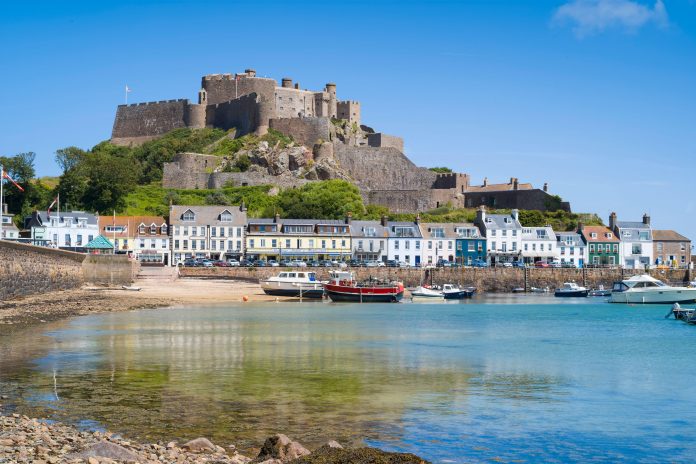
A unique blend of English and French influences, fascinating Jersey, in the Channel Islands is a delight for history buffs
Words Natasha Foges
What are the Channel Islands?
Tucked into the Bay of Saint-Malo, the Channel Islands may sit tête-à-tête with the coast of France, but these magical islands are resolutely British. The archipelago became part of the Anglo-Norman realm when William the Conqueror became King of England in 1066. In 1204, when King John lost Normandy to France, the islanders chose to remain loyal to the English Crown. They were granted the right to self-govern in return.
Jersey
You can explore this unique heritage on a trip to Jersey, the largest of the Channel Islands. It is really a miniature country. It has its own government, its own mint and its own flag. It’s the only place in the British Isles where you’ll still be given pound notes in your change.
Though English is the official language, Jersey’s ties to France run deep. Norman roots linger in the island’s street names. Some, such as Rue Trousse Cotillon offer charming glimpses of a bygone age. ‘Tuck-up-your-petticoat Street’ dates from the time when a stream ran down the middle. Jèrriais, an ancient language derived from Norman French, is still spoken, though little heard these days.
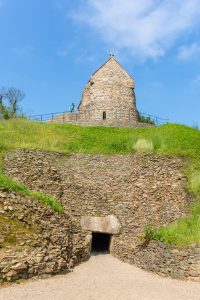
The history of Jersey
Jersey’s rich history draws visitors from far and wide. Despite the island’s small size – just nine miles by five – you can trace a timeline of millennia as you travel along its coastline. It is dotted with fortresses and castles. The sleepy villages and winding lanes of the interior call to mind 1950s rural England.
Jersey’s ancient history
One such lane, brimming with wildflowers, leads you to La Hougue Bie, a remarkably well-preserved passage grave. Although officially the sixth oldest building in the world, dating from 4000–3500 BC, step inside the ancient chamber and you may well have this quietly atmospheric site to yourself. Built to align with the rising sun at spring and summer equinox, it was once a place of sacred rituals and ceremonies.
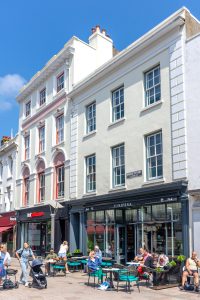
Jersey’s medieval and Tudor history
It takes just a few minutes to hop from Neolithic to medieval times. A drive through leafy lanes takes you to Mont Orgueil Castle.This is a formidable fortress perched on a rocky promontory overlooking Gorey village. It protected islanders against invasion from the 13th century, and its network of towers, staircases and secret rooms lead to lofty battlements with sky-high views of the countryside and the distant French coast.
The castle fell out of use in the late 16th century, when Elizabeth I was advised that it was in the wrong position to ward off French raids. A plan to demolish the old castle and recycle its stones in a new fortification was abandoned thanks to Sir Walter Raleigh, Governor of Jersey from 1600. He oversaw the building of a new castle on a rocky islet just outside the harbour of Jersey’s capital, St Helier, and named it after the queen.
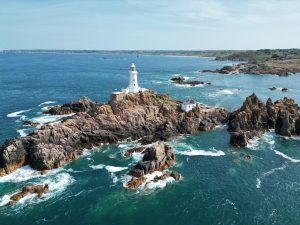
Jersey and King Charles II
Elizabeth Castle, which can now be reached either by the amphibious Castle Ferry or on foot along the causeway at low tide, provided sanctuary to the fugitive Prince Charles during the English Civil War. He stayed at the castle for 10 weeks in 1645, returning after the execution of his father to be crowned Charles II in 1649
The king was full of gratitude to the islanders that had offered him a refuge, naming a newly established colony in America New Jersey in thanks.
Regency and Victorian history in Jersey
There’s more time-travelling to be done in bustling St Helier. Royal Square, where the Jersey parliament sits, was the site of the Battle of Jersey in 1781. This was a brief but bloody defeat for the French. They never attempted invasion again, though the threat of it was never far from islanders’ minds, as is clear from a visit to 16 New Street. At this magnificently restored ‘house museum’ you’re transported to a Regency household, with evocative sounds and smells that enhance the experience. You may even be offered a biscuit in the kitchen by the entertaining costumed cook.
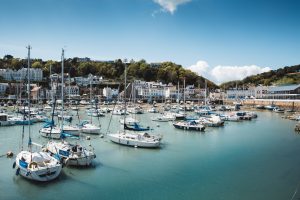
A few minutes’ walk away is a second immersive museum, the Victorian House, part of Jersey Museum. This impeccably restored, gas-lit townhouse is presented as if the well-to-do owners have just put all of their belongings up for auction to embark on a new life in France. Their story is revealed as you walk from room to room.
Just outside St Helier, Samarès Manor is owned by the Seigneur of Samarès, a title with roots in the island’s feudal past. The spectacular botanic garden surrounding the manor dates from the 1920s and is renowned for its herb garden, with fragrant and medicinal herbs planted in large sections within an abstract array of gravel paths.
German occupation of Jersey
The most famous period of Jersey’s history is also its darkest. In the Second World War Jersey and its fellow Channel islands, Guernsey, Alderney and Sark, became the only British territory to be occupied by the Nazis. Jersey is scattered with reminders of the occupation, from batteries and bunkers to tunnels and observation towers.
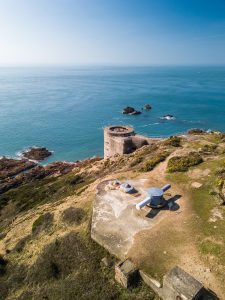
So numerous are these wartime relics that you’re likely to spot a bunker or two on any coastal stroll. To learn what life was like during the five long years of occupation, visit the Jersey War Tunnels. Housed in a labyrinthine underground complex built by the Nazis using slave labour, exhibitions pay tribute to the hardship and heroism of that time.
To really get a feel for the scale of the Nazi operation, take a night tour with the non-profit Jersey War Tours. You’ll be taken into bunkers not usually open to the public and packed with genuine artefacts: an illuminating, and at times chilling, experience.
Liberation finally happened on 9 May 1945, when islanders triumphantly hoisted the Union Flag in St Helier. This was a moment immortalised in a dramatic sculpture in what is now called Liberation Square. The flag-hoisting is recreated (amid much general flag-waving, parades and marching bands) every year on Liberation Day.
Jersey’s beautiful landscapes
You could spend days exploring Jersey’s historical sights, but spare time too for its natural wonders. The island’s stunning sandy beaches bask in more hours of sunshine than anywhere else in the British Isles. Beaches range from vast St Ouen’s Bay in the west, battered by Atlantic rollers and beloved of surfers, to the tiny harbour of Rozel on the east coast, filled with fishing boats and sheltered by lush green hills. The south coast beaches such as St Aubin’s and St Brelade’s are sandy and sheltered. The cliffs of the wild north coast, of pinkish granite, make a memorable place for a stroll. And the deep blue sea far below and the salty air sweetened with the coconut scent of gorse.
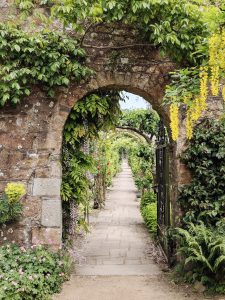
Jersey has one of the largest tides in the world, and the island almost doubles in size at low tide. This opens up lots of opportunities for picturesque walks, including to the landmark Corbière Lighthouse at the island’s southwestern tip. At low tide, it can be reached by way of a dramatic causeway flanked by dark lunar-like rocks.
Jersey cuisine
Keep an eye out for locals scouring the rocks in search of the elusive ormer. These are limpets with a mother-of-pearl shell that’s prized by gourmets for its unique flavour. ‘Ormering’ is only permitted on the first day of each full moon between October and April and the following three days, to protect these rare creatures. If you’re not lucky enough to sample one, oysters are a good substitute – as fresh and tasty on Jersey as you’ll find anywhere.
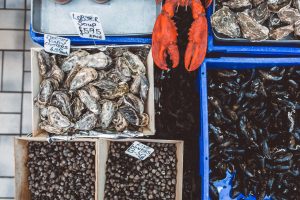
While seafood is a must on any foodie itinerary of Jersey, there are a few other must-tries. Jersey Royals are the king of new potatoes, best served slathered in creamy Jersey butter. Farmers swear by the method of spreading seaweed (locally known as vraic) on their potato fields – a practice that dates as far back as the 12th century.
Don’t leave the island without sampling Jersey black butter – which is in fact not butter at all, but a rich conserve of apples, cider, lemon, liquorice and spices. It can be served with sweet or savoury dishes, or simply spread on a scone. Family recipes are passed down through the generations, and production is a communal affair. Tradition dictates that the jam-like concoction must be stirred continuously by hand for many hours. Those not partaking in the stirring are entertained by folk dances, singing and storytelling through the night.
A batch of rosy English apples, a glug of French-style cider, a sprinkling of tradition and a dab of history: it’s Jersey on a plate.
Hopping to the other Channel Islands
Guernsey
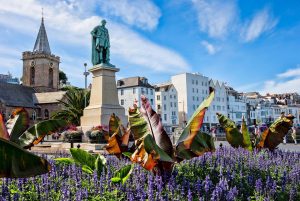
Second biggest of the Channel Islands, Guernsey has a pretty-as-a-picture capital, St Peter Port. The cobbled, bunting-bedecked streets lead down to a pretty harbour. As well as attracting thrill-seekers to its dramatic coastline, who kayak or paddleboard their way from one picturesque bay to the next, Guernsey has cultural attractions galore. Visit Victor Hugo’s extraordinarily ornate home, on which he lavished his creative energies while in exile from France. Or you can take the Renoir Walk to admire views that inspired the artist in 1883. Or why not tour some of the island’s historic sites, from 800- year-old Castle Cornet to the moving Occupation Museum.
Sark
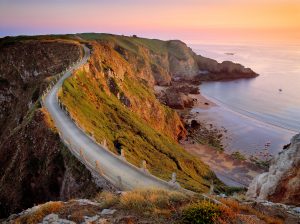
Looking to escape the modern world for a while? There’s no better place than Sark. This tiny jewel of an island – just 2.1 square miles – is entirely car-free, so the pace of life is slow and gentle. Spend your days cycling through wildflower-filled meadows, strolling the craggy coastline and swimming in unspoilt coves. By night, take a horse-drawn carriage ride to gaze at the night sky. With no street lights on the island, the skies glitter spectacularly with stars and meteors.
Alderney

Little Alderney, the most northerly of the main Channel Islands, offers scenic cliff paths, pristine sandy beaches and a quaint capital in the town of St Anne. Diverse landscapes, from windswept heathland to lush woodland, make it a haven for wildlife. On a country stroll you will spot all kinds of creatures, from seals and dolphins to rare butterflies and maybe even a Blonde Hedgehog. The prickly creatures thrive here and are the island’s undisputed icon.
This is an extract, read the full feature on Jersey and the Channel Islands in the May/June 2024 issue of BRITAIN, available to buy here from Friday 5 April.
Read more from BRITAIN:





 © 2024
© 2024